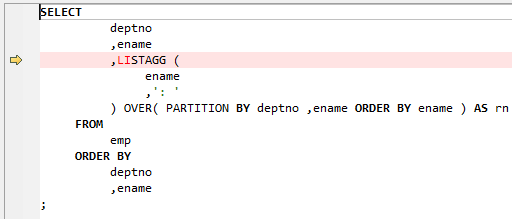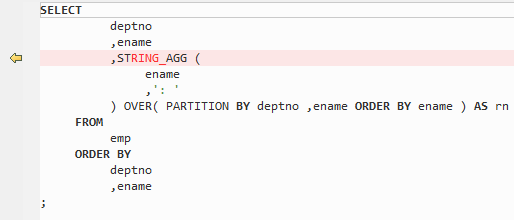String Functions
This section describes the following string functions:
LISTAGG
LISTAGG is used to order data in columns within each group specified in the ORDER BY clause and concatenates the order results.


LISTAGG can be migrated after MigSupportForListAgg is set to false.
Input- LISTAGG
1 2 3 4 5 6 7 |
SELECT LISTAGG(BRANCH_ID, ',') WITHIN GROUP(ORDER BY AREA_ORDER) PRODUCTRANGE FROM (SELECT DISTINCT VB.BRANCH_ID, VB.VER_ID, VB.AREA_ORDER FROM SPMS_VERSION_BRANCH VB, SPMS_NODE_SET NS WHERE VB.BRANCH_TYPE IN ('1', '3') AND VB.AGENCY_BRANCH = NS.BRANCH_ID); |
Output
1 2 3 4 5 6 7 8 9 10 11 12 13 |
SELECT LISTAGG (BRANCH_ID,',') WITHIN GROUP ( ORDER BY AREA_ORDER ) PRODUCTRANGE FROM ( SELECT DISTINCT VB.BRANCH_ID ,VB.VER_ID ,VB.AREA_ORDER FROM SPMS_VERSION_BRANCH VB ,SPMS_NODE_SET NS WHERE VB.BRANCH_TYPE IN ( '1','3') AND VB.AGENCY_BRANCH = NS.BRANCH_ID) ; |
STRAGG
STRAGG is a string aggregate function used to collect values from multiple rows into a comma-separated string.
Input-STRAGG
1 2 3 |
SELECT DEPTNO,ENAME,STRAGG(ename) over (partition by deptno order by ename RANGE BETWEEN UNBOUNDED PRECEDING AND UNBOUNDED FOLLOWING) AS ENAME_STR FROM EMP; |
Output
1 2 3 4 5 6 |
SELECT DEPTNO,ENAME,STRING_AGG ( ename,',') over( partition BY deptno ORDER BY ename RANGE BETWEEN UNBOUNDED PRECEDING AND UNBOUNDED FOLLOWING ) AS ENAME_STR FROM EMP ; |
WM_CONCAT
WM_CONCAT is used to aggregate data from a number of rows into a single row, giving a list of data associated with a specific value.


NVL2 and REPLACE
NVL2( expression, value1, value2) is a function used to determine the value returned by a query based on whether a specified expression is null or not. If the expression is not null, then NVL2 returns value1. If the expression is null, then NVL2 returns value 2.
Input - NVL2
1
|
NVL2(Expr1, Expr2, Expr3) |
Output
1
|
DECODE(Expr1, NULL, Expr3, Expr2) |
The REPLACE function is used to return char with every occurrence of search_string replaced with replacement_string. If replacement_string is omitted or null, then all occurrences of search_string are removed.
The REPLACE function in Oracle contains two mandatory parameters and one optional parameter. The REPLACE function in GaussDB(DWS) contains three mandatory parameters.
Input - Nested REPLACE
1 2 3 4 5 6 7 8 9 10 |
CREATE OR REPLACE FUNCTION F_REPLACE_COMMA ( IS_STR IN VARCHAR2 ) RETURN VARCHAR2 IS BEGIN IF IS_STR IS NULL THEN RETURN NULL ; ELSE RETURN REPLACE( REPLACE( IS_STR ,'a' ) ,CHR ( 10 ) ) ; END IF ; END F_REPLACE_COMMA ; / |
Output
1 2 3 4 5 6 7 8 9 10 |
CREATE OR REPLACE FUNCTION F_REPLACE_COMMA ( IS_STR IN VARCHAR2 ) RETURN VARCHAR2 IS BEGIN IF IS_STR IS NULL THEN RETURN NULL ; ELSE RETURN REPLACE( REPLACE( IS_STR ,'a' ,'' ) ,CHR ( 10 ) ,'' ) ; END IF ; end ; / |
Input - More than one REPLACE
1 2 3 4 5 6 7 |
SELECT REPLACE( 'JACK and JUE' ,'J', '' ) "Changes" ,REPLACE( 'JACK1 and JUE' ,'J' ) "Changes1" ,REPLACE( 'JACK2 and JUE' ,'J' ) "Changes2" FROM DUAL ; |
Output
1 2 3 4 5 6 7 |
SELECT REPLACE( 'JACK and JUE' ,'J' ,'' ) "Changes" ,REPLACE( 'JACK1 and JUE' ,'J' ,'' ) "Changes1" ,REPLACE( 'JACK2 and JUE' ,'J' ,'' ) "Changes2" FROM DUAL ; |
Input - REPLACE with Three parameters
1 2 3 4 5 |
SELECT REPLACE( '123tech123' ,'123', '1') FROM dual ; |
Output
1 2 3 4 5 |
SELECT REPLACE( '123tech123' ,'123' , '1' ) FROM dual ; |
QUOTE
QUOTE allows the user to embed single-quotes in literal strings without having to resort to double quotes. That is, you can use single quotes to specify a literal string.
For example:
1
|
SELECT q'[I'm using quote operator in SQL statement]' "Quote (q) Operator" FROM dual; |


Feedback
Was this page helpful?
Provide feedbackThank you very much for your feedback. We will continue working to improve the documentation.






